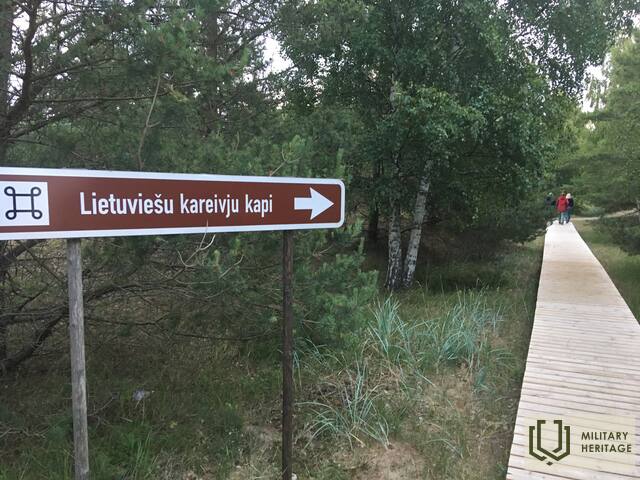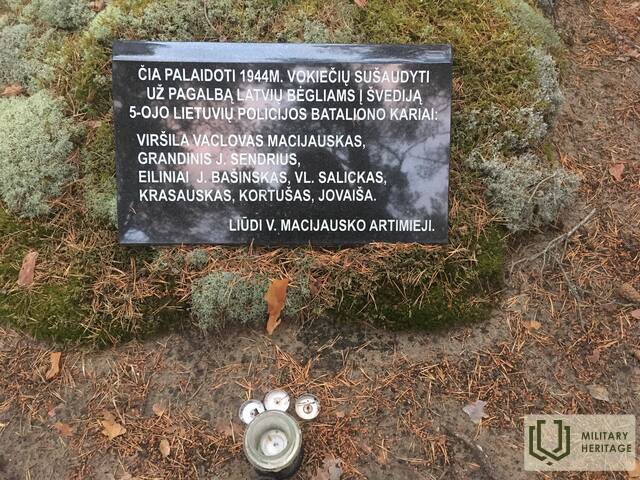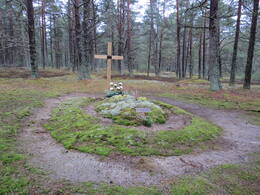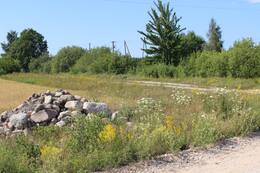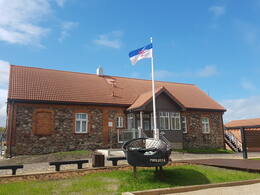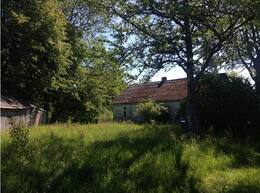Compassionate Lithuanian Coastguard men
More than 70 years ago, Lithuanian coastguards were executed for helping their neighbours, Latvian boat refugees, to reach Sweden. When the German occupation authorities found out about this, they brutally
One of the tasks of the Lithuanian coastguard, besides being ready to fight enemy landings and to report enemy ships, was to prevent Latvian refugee boats from reaching the island of Gotland, 160 kilometres away, which could be reached in 12-14 hours by a fishing motorboat.
Later, however, the Lithuanian coastguards became good friends of the Latvian refugees and regretted their reckless firing during the reception of the refugees in the boats. The boat refugees who took refuge in the vicinity also had to be wary of the Soviet "Red Arrow" militia unit that was on the rampage here, which not only robbed civilians, but also killed one Lithuanian coastguard and wounded another on the Jūrkalne coast in December 1944.
However, news of the Lithuanian coastguard's assistance to Latvian refugees and the Lithuanians' own preparations to cross the sea to Sweden also reached the Germans.
On 10 January 1945, the soldiers of the 1st Company of the 5th Lithuanian Police Battalion were gathered in the old dispensary building in the Market Square of Pavilosta to give them a rest, but in reality they were disarmed and surrounded by German gendarmerie units by deception. More than a week of interrogation and trial followed, which, as a warning to the others, decided to execute seven Lithuanian soldiers and imprison 11 more of their comrades in concentration camps in Germany. The execution of the seven Lithuanian soldiers (Sergeant Macijauski, the company commander; Juozas Sendrjuas, a soldier; Vladas Salickas, a soldier; Ionas Bašinskis, Krasauskas and two unknown others) took place on 21 January 1945 in the Zaļkalns Pines in Pavilosta.
It was possible to talk about them openly only almost half a century later, when, on the initiative of Edīte Biģeles, a member of the Pāvilosta branch of the Latvian Popular Front, Pāvilosta residents, together with the Liepāja Lithuanian Cultural Society, cleaned up the Zaļkalna Forest burial site in 1994 and installed a white grave cross for the soldiers who were shot here. Ten years later, the student unit "Austrums" installed a special road sign with the inscription "Cemetery of Lithuanian Brothers of the Coast Guard (1944-1945). Shot for helping Latvian refugees", cut a stile and marked the path from the seashore to the gravesite of the Lithuanian soldiers with posts.
For several years now, encouraged by Irina Kurčanová, the director of the Pāvilosta Museum of Local History, the people of the museum have been cleaning the site every spring, giving all who wish the opportunity to lay flowers and remember the Lithuanian Coast Guard soldiers who were executed more than 70 years ago for their help to their neighbours, the Latvian boat refugees to Sweden.
https://www.la.lv/lietuviesu-karaviru-drama-latvija
Related timeline
Related objects
Lithuanian soldiers' graves in Zaļkalns Forest
The memorial is located near the Pāvilosta beach lookout tower in the dunes. There are signs pointing to the memorial.
At the end of the Second World War, three Lithuanian police battalions, the 5th, 13th and 256th, were also deployed in Latvia, and after guard duty and fighting against Soviet partisans and the Red Army on the Eastern Front, from autumn 1944 they were involved in guarding the Baltic Sea coast in Kurzeme.
In October 1944, all three battalions, consisting of 32 officers and about 900 instructors and soldiers, were subordinated to the German 18th Army's 583rd Rear Guard Unit (Koruck 583). The unit was tasked with guarding the Kurzeme coast from Liepāja to Ventspils. All three Lithuanian battalions were deployed in the vicinity of Pavilosta. In December 1944, the 13th Battalion was transferred to the German 1st Army Corps at the Liepaja Lake.
One of the tasks of the Lithuanian coastguard, besides being ready to fight enemy landings and to report enemy ships, was to prevent Latvian refugee boats from sailing to the island of Gotland, 160 kilometres away, but the Lithuanian coastguard men did not prevent the refugee boats from leaving. However, news of the Lithuanian coastguard helping the Latvian refugees and the Lithuanians themselves preparing to cross the sea to Sweden also reached the Germans.
On 10 January 1945, the soldiers of the 1st Company of the 5th Lithuanian Police Battalion were rounded up. More than a week of interrogation and trial followed, which, as a warning to the others, decided to execute seven of the Lithuanian soldiers and to imprison 11 of their comrades in concentration camps in Germany. The execution of the seven Lithuanian soldiers (Sergeant Macijauski, the company commander; Juozas Sendrjuas, a soldier; Vladas Salickas, a soldier; Ionas Bašinskis, Krasauskas and two unknown others) took place on 21 January 1945 in the Zaļkalns Pines in Pavilosta.
In January 1945, the 5th Battalion was disbanded and the combat-ready soldiers were divided into the two remaining battalions, while the rest were formed into a separate sapper company. At the time of the surrender of Army Group Kurzeme in May 1945, two battalions (13th and 256th) were still in Kurzeme as a sapper company with a total of 900 soldiers who were taken prisoner by the Soviets.
The road to the "Grīnieki" house in Vārve parish
The road to the “Grīnieki” houses in Vārve parish, where in 1944 one of the main settlements for boat refugees on the Kurzeme coast was located.
Memories of boatman V. Jurjakas: “Entering the “Grīnieki” yard, everything looks very normal. A quiet country house, not a soul, probably people in the sun. [..] It turned out that not only the “Grīnieki” residential house was full of people, but all the buildings were full. The barn, the granary, the hayloft and the bathhouse. I met one or two acquaintances, because it was time to leave our land. [..] The nutritional situation was not critical, but quite poor. [..] In the evening, the refugee caravan began to move towards the seashore. I warned everyone in advance not to come out of the bushes by the seashore, because there were coast guard dugouts and observation posts nearby. It was a large caravan, because about 200 people were going to the seashore. There was no hope that everyone would arrive on time. The evening was not very dark, and I was able to review the activities of the entire group. The most striking were the large "When people lived in "Grīnieki", they didn't see them, but now, when they were brought into the light, they only saw this. The goods alone required a whole boat. 3-4 two-horse carts were loaded with goods, followed by people. [..] We waited for the boat for a long time, but it didn't come. The whole caravan had to turn back. It was very dark."
Pāvilosta local history museum exposition
Named ‘Pāvilosta, a Closed Area’, the exhibit in the Pāvilosta Local History Museum is about everyday life in the town of Pāvilosta during the Soviet occupation; specifically, about the executive branch, border area, fishermen’s collective farm, and the cultural and social activities. In addition to the permanent exhibit, there is an interactive and emotionally rich digital exhibit in two languages and an audio-visual installation offering a film about Pāvilosta.
The museum also features a new exhibit named ‘The Golden Sand Grains of Pāvilosta’. The digital installation showcases old events, how Pāvilosta was founded and the most important developments from 1918 to the present day. Military heritage is a point of focus in the War of Independence section, which tells a story about the freedom fighters of Latvia and the time of the Soviet occupation.
"Laukgaļi" houses, the residence of the writer Kārlis Skalbe
“Laukgaļi” in Jūrkalne parish, the place where writer Kārlis Skalbe stayed in October - November 1944, while waiting for a refugee boat to Sweden.
Writer Kārlis Skalbe (1879–1945) was a member of the Latvian Provisional National Council and the Latvian People's Council, a deputy of the Constitutional Assembly of the Republic of Latvia and the 1st and 4th Saeima. During the German occupation, he was the editor-in-chief of the literary magazine "Latvju Mēnešraksts", one of the signatories of the LCP memorandum of March 17, 1944.
On November 11, 1944, she fled to Sweden. She died in 1945 in Stockholm.




